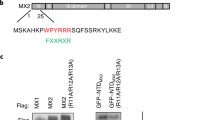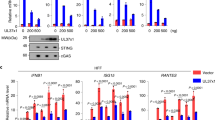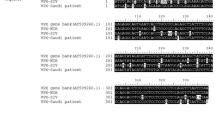Abstract
The host restriction factor sterile alpha motif and histidine–aspartate domain-containing protein 1 (SAMHD1) is an important component of the innate immune system. By regulating the intracellular nucleotide pool, SAMHD1 influences cell division and restricts the replication of viruses that depend on high nucleotide concentrations. Human cytomegalovirus (HCMV) is a pathogenic virus with a tropism for non-dividing myeloid cells, in which SAMHD1 is catalytically active. Here we investigate how HCMV achieves efficient propagation in these cells despite the SAMHD1-mediated dNTP depletion. Our analysis reveals that SAMHD1 has the capability to suppress HCMV replication. However, HCMV has evolved potent countermeasures to circumvent this block. HCMV interferes with SAMHD1 steady-state expression and actively induces SAMHD1 phosphorylation using the viral kinase pUL97 and by hijacking cellular kinases. These actions convert SAMHD1 to its inactive phosphorylated form. This mechanism of SAMHD1 inactivation by phosphorylation might also be used by other viruses to overcome intrinsic immunity.
This is a preview of subscription content, access via your institution
Access options
Access Nature and 54 other Nature Portfolio journals
Get Nature+, our best-value online-access subscription
$29.99 / 30 days
cancel any time
Subscribe to this journal
Receive 12 digital issues and online access to articles
$119.00 per year
only $9.92 per issue
Buy this article
- Purchase on SpringerLink
- Instant access to full article PDF
Prices may be subject to local taxes which are calculated during checkout






Similar content being viewed by others
Data availability
All data generated and analysed during this study are included in this published manuscript. Further datasets supporting this study are available from the corresponding author upon request.
References
Landolfo, S., De Andrea, M., Dell’Oste, V. & Gugliesi, F. Intrinsic host restriction factors of human cytomegalovirus replication and mechanisms of viral escape. World J. Virol. 5, 87–96 (2016).
Ahn, J. H. & Hayward, G. S. Disruption of PML-associated nuclear bodies by IE1 correlates with efficient early stages of viral gene expression and DNA replication in human cytomegalovirus infection. Virology 274, 39–55 (2000).
Adler, M., Tavalai, N., Muller, R. & Stamminger, T. Human cytomegalovirus immediate–early gene expression is restricted by the nuclear domain 10 component Sp100. J. Gen. Virol. 92, 1532–1538 (2011).
Wagenknecht, N. et al. Contribution of the major ND10 proteins PML, hDaxx and Sp100 to the regulation of human cytomegalovirus latency and lytic replication in the monocytic cell line THP-1. Viruses 7, 2884–2907 (2015).
Gariano, G. R. et al. The intracellular DNA sensor IFI16 gene acts as restriction factor for human cytomegalovirus replication. PLoS Pathog. 8, e1002498 (2012).
Biolatti, M. et al. Regulatory interaction between the cellular restriction factor IFI16 and Viral pp65 (pUL83) modulates viral gene expression and IFI16 protein stability. J. Virol. 90, 8238–8250 (2016).
Dell’Oste, V. et al. Innate nuclear sensor IFI16 translocates into the cytoplasm during the early stage of in vitro human cytomegalovirus infection and is entrapped in the egressing virions during the late stage. J. Virol. 88, 6970–6982 (2014).
Goldstone, D. C. et al. HIV-1 restriction factor SAMHD1 is a deoxynucleoside triphosphate triphosphohydrolase. Nature 480, 379–382 (2011).
Hollenbaugh, J. A. et al. dNTP pool modulation dynamics by SAMHD1 protein in monocyte-derived macrophages. Retrovirology 11, 63 (2014).
Powell, R. D., Holland, P. J., Hollis, T. & Perrino, F. W. Aicardi–Goutieres syndrome gene and HIV-1 restriction factor SAMHD1 is a dGTP-regulated deoxynucleotide triphosphohydrolase. J. Biol. Chem. 286, 43596–43600 (2011).
Pauls, E. et al. Cell cycle control and HIV-1 susceptibility are linked by CDK6-dependent CDK2 phosphorylation of SAMHD1 in myeloid and lymphoid cells. J. Immunol. 193, 1988–1997 (2014).
St Gelais, C. et al. Identification of cellular proteins interacting with the retroviral restriction factor SAMHD1. J. Virol. 88, 5834–5844 (2014).
Yan, J. et al. CyclinA2–cyclin-dependent kinase regulates SAMHD1 protein phosphohydrolase domain. J. Biol. Chem. 290, 13279–13292 (2015).
Cribier, A., Descours, B., Valadao, A. L., Laguette, N. & Benkirane, M. Phosphorylation of SAMHD1 by cyclin A2/CDK1 regulates its restriction activity toward HIV-1. Cell Rep. 3, 1036–1043 (2013).
Hrecka, K. et al. Vpx relieves inhibition of HIV-1 infection of macrophages mediated by the SAMHD1 protein. Nature 474, 658–661 (2011).
Laguette, N. et al. SAMHD1 is the dendritic- and myeloid-cell-specific HIV-1 restriction factor counteracted by Vpx. Nature 474, 654–657 (2011).
Lahouassa, H. et al. SAMHD1 restricts the replication of human immunodeficiency virus type 1 by depleting the intracellular pool of deoxynucleoside triphosphates. Nat. Immunol. 13, 223–228 (2012).
White, T. E. et al. The retroviral restriction ability of SAMHD1, but not its deoxynucleotide triphosphohydrolase activity, is regulated by phosphorylation. Cell Host Microbe 13, 441–451 (2013).
Welbourn, S., Dutta, S. M., Semmes, O. J. & Strebel, K. Restriction of virus infection but not catalytic dNTPase activity is regulated by phosphorylation of SAMHD1. J. Virol. 87, 11516–11524 (2013).
Welbourn, S. & Strebel, K. Low dNTP levels are necessary but may not be sufficient for lentiviral restriction by SAMHD1. Virology 488, 271–277 (2016).
Ryoo, J. et al. The ribonuclease activity of SAMHD1 is required for HIV-1 restriction. Nat. Med. 20, 936–941 (2014).
Gramberg, T. et al. Restriction of diverse retroviruses by SAMHD1. Retrovirology 10, 26 (2013).
Herrmann, A., Happel, A. U. & Gramberg, T. SAMHD1 in retroviral restriction and innate immune sensing—should we leash the hound? Curr. HIV Res. 14, 225–234 (2016).
Sze, A. et al. Host restriction factor SAMHD1 limits human T cell leukemia virus type 1 infection of monocytes via STING-mediated apoptosis. Cell Host Microbe 14, 422–434 (2013).
Badia, R. et al. Inhibition of herpes simplex virus type 1 by the CDK6 inhibitor PD-0332991 (palbociclib) through the control of SAMHD1. J. Antimicrob. Chemother. 71, 387–394 (2016).
Chen, Z. et al. Inhibition of hepatitis B virus replication by SAMHD1. Biochem. Biophys. Res. Commun. 450, 1462–1468 (2014).
Hollenbaugh, J. A. et al. Host factor SAMHD1 restricts DNA viruses in non-dividing myeloid cells. PLoS Pathog. 9, e1003481 (2013).
Jeong, G. U., Park, I. H., Ahn, K. & Ahn, B. Y. Inhibition of hepatitis B virus replication by a dNTPase-dependent function of the host restriction factor SAMHD1. Virology 495, 71–78 (2016).
Kim, E. T., White, T. E., Brandariz-Nunez, A., Diaz-Griffero, F. & Weitzman, M. D. SAMHD1 restricts herpes simplex virus 1 in macrophages by limiting DNA replication. J. Virol. 87, 12949–12956 (2013).
Sommer, A. F. et al. Restrictive influence of SAMHD1 on hepatitis B virus life cycle. Sci. Rep. 6, 26616 (2016).
Sinzger, C., Digel, M. & Jahn, G. Cytomegalovirus cell tropism. Curr. Top. Microbiol. Immunol. 325, 63–83 (2008).
Sinzger, C., Plachter, B., Grefte, A., The, T. H. & Jahn, G. Tissue macrophages are infected by human cytomegalovirus in vivo. J. Infect. Dis. 173, 240–245 (1996).
Ibanez, C. E., Schrier, R., Ghazal, P., Wiley, C. & Nelson, J. A. Human cytomegalovirus productively infects primary differentiated macrophages. J. Virol. 65, 6581–6588 (1991).
Minton, E. J., Tysoe, C., Sinclair, J. H. & Sissons, J. G. Human cytomegalovirus infection of the monocyte/macrophage lineage in bone marrow. J. Virol. 68, 4017–4021 (1994).
Sinzger, C. et al. Macrophage cultures are susceptible to lytic productive infection by endothelial-cell-propagated human cytomegalovirus strains and present viral IE1 protein to CD4+ T cells despite late downregulation of MHC class II molecules. J. Gen. Virol. 87, 1853–1862 (2006).
St Gelais, C. & Wu, L. SAMHD1: a new insight into HIV-1 restriction in myeloid cells. Retrovirology 8, 55 (2011).
Berger, G. et al. Functional analysis of the relationship between Vpx and the restriction factor SAMHD1. J. Biol. Chem. 287, 41210–41217 (2012).
Hofmann, H. et al. The Vpx lentiviral accessory protein targets SAMHD1 for degradation in the nucleus. J. Virol. 86, 12552–12560 (2012).
Wittmann, S. et al. Phosphorylation of murine SAMHD1 regulates its antiretroviral activity. Retrovirology 12, 103 (2015).
Baldauf, H. M. et al. SAMHD1 restricts HIV-1 infection in resting CD4+ T cells. Nat. Med. 18, 1682–1687 (2012).
Le, V. T., Trilling, M., Wilborn, M., Hengel, H. & Zimmermann, A. Human cytomegalovirus interferes with signal transducer and activator of transcription (STAT) 2 protein stability and tyrosine phosphorylation. J. Gen. Virol. 89, 2416–2426 (2008).
Marshall, E. E. & Geballe, A. P. Multifaceted evasion of the interferon response by cytomegalovirus. J. Interferon Cytokine Res. 29, 609–619 (2009).
Paulus, C., Krauss, S. & Nevels, M. A human cytomegalovirus antagonist of type I IFN-dependent signal transducer and activator of transcription signaling. Proc. Natl Acad. Sci. USA 103, 3840–3845 (2006).
Riess, M. et al. Interferons induce expression of SAMHD1 in monocytes through down-regulation of miR-181a and miR-30a. J. Biol. Chem. 292, 264–277 (2017).
St Gelais, C. et al. SAMHD1 restricts HIV-1 infection in dendritic cells (DCs) by dNTP depletion, but its expression in DCs and primary CD4+ T-lymphocytes cannot be upregulated by interferons. Retrovirology 9, 105 (2012).
Pauls, E. et al. Palbociclib, a selective inhibitor of cyclin-dependent kinase4/6, blocks HIV-1 reverse transcription through the control of sterile α motif and HD domain-containing protein-1 (SAMHD1) activity. AIDS 28, 2213–2222 (2014).
He, Z. et al. The human cytomegalovirus UL97 protein is a protein kinase that autophosphorylates on serines and threonines. J. Virol. 71, 405–411 (1997).
Oberstein, A., Perlman, D. H., Shenk, T. & Terry, L. J. Human cytomegalovirus pUL97 kinase induces global changes in the infected cell phosphoproteome. Proteomics 15, 2006–2022 (2015).
Prichard, M. N. Function of human cytomegalovirus UL97 kinase in viral infection and its inhibition by maribavir. Rev. Med. Virol. 19, 215–229 (2009).
Prichard, M. N. et al. A recombinant human cytomegalovirus with a large deletion in UL97 has a severe replication deficiency. J. Virol. 73, 5663–5670 (1999).
Biron, K. K. et al. Potent and selective inhibition of human cytomegalovirus replication by 1263W94, a benzimidazole l-riboside with a unique mode of action. Antimicrob. Agents Chemother. 46, 2365–2372 (2002).
Kaspari, M. et al. Proteasome inhibitor MG132 blocks viral DNA replication and assembly of human cytomegalovirus. FEBS Lett. 582, 666–672 (2008).
Kalejta, R. F. & Shenk, T. Manipulation of the cell cycle by human cytomegalovirus. Front. Biosci. 7, d295–d306 (2002).
Spector, D. H. Human cytomegalovirus riding the cell cycle. Med. Microbiol. Immunol. 204, 409–419 (2015).
Bresnahan, W. A., Boldogh, I., Chi, P., Thompson, E. A. & Albrecht, T. Inhibition of cellular Cdk2 activity blocks human cytomegalovirus replication. Virology 231, 239–247 (1997).
Bresnahan, W. A., Boldogh, I., Thompson, E. A. & Albrecht, T. Human cytomegalovirus inhibits cellular DNA synthesis and arrests productively infected cells in late G1. Virology 224, 150–160 (1996).
Chen, Z., Knutson, E., Kurosky, A. & Albrecht, T. Degradation of p21cip1 in cells productively infected with human cytomegalovirus. J. Virol. 75, 3613–3625 (2001).
Jault, F. M. et al. Cytomegalovirus infection induces high levels of cyclins, phosphorylated Rb, and p53, leading to cell cycle arrest. J. Virol. 69, 6697–6704 (1995).
Salvant, B. S., Fortunato, E. A. & Spector, D. H. Cell cycle dysregulation by human cytomegalovirus: influence of the cell cycle phase at the time of infection and effects on cyclin transcription. J. Virol. 72, 3729–3741 (1998).
Wiebusch, L. & Hagemeier, C. The human cytomegalovirus immediate early 2 protein dissociates cellular DNA synthesis from cyclin-dependent kinase activation. EMBO J. 20, 1086–1098 (2001).
Sanchez, V., McElroy, A. K. & Spector, D. H. Mechanisms governing maintenance of Cdk1/cyclin B1 kinase activity in cells infected with human cytomegalovirus. J. Virol. 77, 13214–13224 (2003).
Hu, J. et al. Cyclin E2–CDK2 mediates SAMHD1 phosphorylation to abrogate its restriction of HBV replication in hepatoma cells. FEBS Lett. 592, 1893–1904 (2018).
Kalejta, R. F., Bechtel, J. T. & Shenk, T. Human cytomegalovirus pp71 stimulates cell cycle progression by inducing the proteasome-dependent degradation of the retinoblastoma family of tumor suppressors. Mol. Cell. Biol. 23, 1885–1895 (2003).
Kalejta, R. F. & Shenk, T. The human cytomegalovirus UL82 gene product (pp71) accelerates progression through the G1 phase of the cell cycle. J. Virol. 77, 3451–3459 (2003).
Kalejta, R. F. & Shenk, T. Proteasome-dependent, ubiquitin-independent degradation of the Rb family of tumor suppressors by the human cytomegalovirus pp71 protein. Proc. Natl Acad. Sci. USA 100, 3263–3268 (2003).
Caffarelli, N., Fehr, A. R. & Yu, D. Cyclin A degradation by primate cytomegalovirus protein pUL21a counters its innate restriction of virus replication. PLoS Pathog. 9, e1003825 (2013).
Eifler, M. et al. PUL21a–cyclin A2 interaction is required to protect human cytomegalovirus-infected cells from the deleterious consequences of mitotic entry. PLoS Pathog. 10, e1004514 (2014).
Qian, Z., Leung-Pineda, V., Xuan, B., Piwnica-Worms, H. & Yu, D. Human cytomegalovirus protein pUL117 targets the mini-chromosome maintenance complex and suppresses cellular DNA synthesis. PLoS Pathog. 6, e1000814 (2010).
Micochova, P. et al. A G1-like state allows HIV-1 to bypass SAMHD1 restriction in macrophages. EMBO J. 36, 604–616 (2017).
Marschall, M. et al. Cellular p32 recruits cytomegalovirus kinase pUL97 to redistribute the nuclear lamina. J. Biol. Chem. 280, 33357–33367 (2005).
Steingruber, M. et al. Proteomic interaction patterns between human cyclins, the cyclin-dependent kinase ortholog pUL97 and additional cytomegalovirus proteins. Viruses 8, 219 (2016).
Tramentozzi, E. et al. The dNTP triphosphohydrolase activity of SAMHD1 persists during S-phase when the enzyme is phosphorylated at T592. Cell Cycle 17, 1–13 (2018).
Sinzger, C. et al. Modification of human cytomegalovirus tropism through propagation in vitro is associated with changes in the viral genome. J. Gen. Virol. 80, 2867–2877 (1999).
Digel, M., Sampaio, K. L., Jahn, G. & Sinzger, C. Evidence for direct transfer of cytoplasmic material from infected to uninfected cells during cell-associated spread of human cytomegalovirus. J. Clin. Virol. 37, 10–20 (2006).
Tischer, B. K., von Einem, J., Kaufer, B. & Osterrieder, N. Two-step red-mediated recombination for versatile high-efficiency markerless DNA manipulation in Escherichia coli. Biotechniques 40, 191–197 (2006).
Sinzger, C. et al. Cloning and sequencing of a highly productive, endotheliotropic virus strain derived from human cytomegalovirus TB40/E. J. Gen. Virol. 89, 359–368 (2008).
Gramberg, T., Sunseri, N. & Landau, N. R. Evidence for an activation domain at the amino terminus of simian immunodeficiency virus Vpx. J. Virol. 84, 1387–1396 (2010).
Bogdanow, B. et al. Human cytomegalovirus tegument protein pp150 acts as a cyclin A2–CDK-dependent sensor of the host cell cycle and differentiation state. Proc. Natl Acad. Sci. USA 110, 17510–17515 (2013).
Acknowledgements
The authors thank K. Hamprecht for help, critical reading of the manuscript and fruitful discussions, as well as support in measuring and quantifying HCMV genomes; K. Kollender, I. Krotova and S. Wagner for technical assistance; T. Iftner for support and encouragement; the ImageStream and FACS Core Facility of the UKT for help with imaging flow cytometry and cell sorting; the team of the Transfusion Medicine Tübingen (ZKT, T. Bakchoul) for providing Buffy Coat and C. Sinzger, M. Marschall, B. Vetter, M. Winkler and R. Kalejta for providing HCMV constructs and protein kinase inhibitors as well as helpful comments and suggestions. This work was funded in part by basic research support given from the University Hospital Tübingen, Medical Faculty and a DFG (SCHI1073/7-1) grant within the SPP1923 ‘Innate Sensing and Restriction of Retroviruses’ to M.S. T.G. (GR3355/3-1) and J.M. (MI2143/2-1) are also supported by research grants from the DFG. The funders had no role in study design, data collection and interpretation, or the decision to submit the work for publication.
Author information
Authors and Affiliations
Contributions
R.B., J.D., I.G., L.W., T.G. and M.S. designed experiments. R.B. peformed the infection and the IFN-α experiments, FACS measurements and RT–qPCR. Transfection experiments and in vitro kinase assays were done by J.D., I.G. and L.W. R.B., J.D., I.G., L.W., T.G. and M.S. analysed the data. J.M., L.W., T.G. and M.S. contributed reagents and analysis tools. R.B. and M.S. wrote the manuscript. M.S. conceived the overall study and developed the manuscript to its final form. All authors contributed to manuscript editing, read and approved the final manuscript draft.
Corresponding author
Ethics declarations
Competing interests
The authors declare no competing interests.
Additional information
Publisher’s note Springer Nature remains neutral with regard to jurisdictional claims in published maps and institutional affiliations.
Supplementary information
Supplementary Information
Supplementary Figs. 1–9, Supplementary References and raw immunoblot data.
Rights and permissions
About this article
Cite this article
Businger, R., Deutschmann, J., Gruska, I. et al. Human cytomegalovirus overcomes SAMHD1 restriction in macrophages via pUL97. Nat Microbiol 4, 2260–2272 (2019). https://doi.org/10.1038/s41564-019-0557-8
Received:
Accepted:
Published:
Issue Date:
DOI: https://doi.org/10.1038/s41564-019-0557-8



